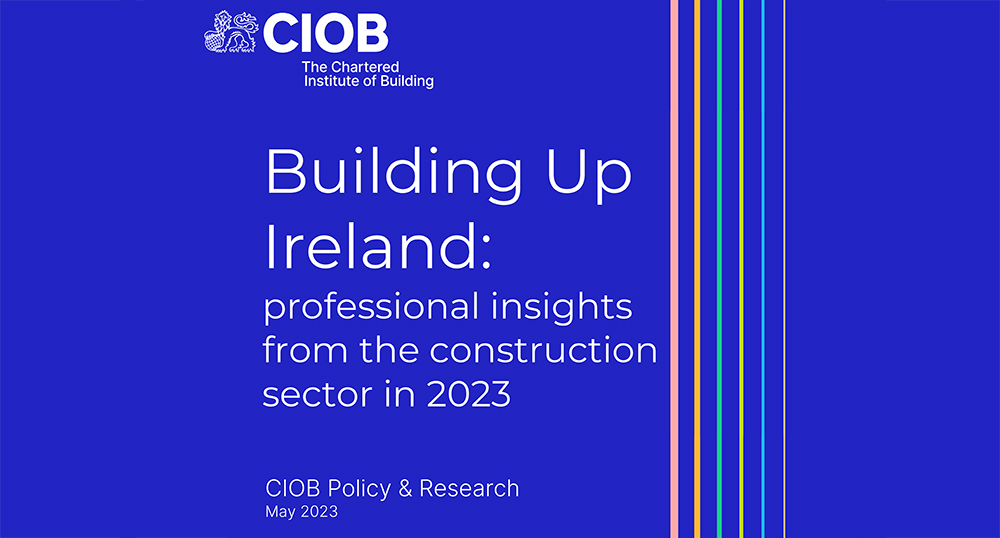Building Up Ireland: professional insights from the construction sector in 2023
Contents |
[edit] Forward
This report provides a snapshot of the unique aspects of Ireland and Northern Ireland's construction industry, offering valuable insights into market trends, regulatory frameworks, and future prospects. The report serves as a useful resource for understanding the changing nature of construction sector in Ireland and Northern Ireland and the potential it holds for sustainable economic advancement.
The report focuses on the short, medium, and long term challenges facing the sector, and makes a series of policy recommendations on the basis of the data gathered.
[edit] Introduction (extract from report)
Ireland’s emergence from the 2008 financial crisis has been a long process. Consecutive years of cuts to public spending and increases in income and other taxes depressed economic activity in the crisis’ aftermath. The construction sector was the hardest hit of all, concurrently reeling from the effects of a burst housing bubble. A massive shedding of jobs led to a major loss of skills and experience. People with knowledge built up from years of training and working in the sector could no longer find employment, and many emigrated. Unsurprisingly, when the economy eventually began to recover the sector had a hard time in meeting the demands that were being placed on it (TASC & CIOB, 2021).
The picture for construction in Ireland in 2023 is quite different. With the sector having experienced a resurgence over the last decade and a remarkable bounce back since COVID-19, there is once again high demand for construction, driven largely by infrastructure and non-residential building. Dovetailing with Ireland’s National Development Plan, the continual demand for development means the Government has an opportunity to put in place a long-term pipeline of projects to secure an historically economically cyclical sector.
It is, therefore, essential that working in construction remains an attractive career path. In a world of declining manufacturing employment and the increase of often precarious and poorly paid service jobs, construction work offers a path to improved living standards. At a macro level, it facilitates social mobility. Despite advances elsewhere in the world of work, women remain a minority group in the sector, and the latest year of data shows a considerable drop compared to the previous year (CSO, 2021). However, in 2019, the sector recorded the highest share of women in construction in at least two decades at 7% of workers compared to 4% in 2000. With the world much changed since 2008, and the likelihood of an even more different one post-Covid, the future path of construction work is yet to be tread.
[edit] Executive Summary (extract from report)
This report begins with an economic snapshot of Ireland and Northern Ireland’s construction sectors using data sets from the Central Statistics Office (CSO), the Office of National Statistics (ONS), and Eurostat. While the data suggests the sector is on a secure footing in both Ireland and Northern Ireland, the industry may face contrasting fortunes in each country based on the respective states of Ireland and Northern Ireland’s economies. Following that, expert views gathered during a roundtable discussion with senior members of the CIOB covering short, medium, and long-term challenges facing the construction sector are presented. Themes arising include viability, the policy environment, the pool of labour, and the need for diversity in the sector. The report concludes with a series of policy recommendations based on the data presented.
This article is based on the CIOB research post and report of the same name "Building Up Ireland: Professional insights from the construction sector in 2023" dated, May 30, 2023.
--CIOB
[edit] Related articles on Designing Buildings
Featured articles and news
A change to adoptive architecture
Effects of global weather warming on architectural detailing, material choice and human interaction.
How big is the problem and what can we do to mitigate the effects?
Overheating guidance and tools for building designers
A number of cool guides to help with the heat.
The UK's Modern Industrial Strategy: A 10 year plan
Previous consultation criticism, current key elements and general support with some persisting reservations.
Building Safety Regulator reforms
New roles, new staff and a new fast track service pave the way for a single construction regulator.
Architectural Technologist CPDs and Communications
CIAT CPD… and how you can do it!
Cooling centres and cool spaces
Managing extreme heat in cities by directing the public to places for heat stress relief and water sources.
Winter gardens: A brief history and warm variations
Extending the season with glass in different forms and terms.
Restoring Great Yarmouth's Winter Gardens
Transforming one of the least sustainable constructions imaginable.
Construction Skills Mission Board launch sector drive
Newly formed government and industry collaboration set strategy for recruiting an additional 100,000 construction workers a year.
New Architects Code comes into effect in September 2025
ARB Architects Code of Conduct and Practice available with ongoing consultation regarding guidance.
Welsh Skills Body (Medr) launches ambitious plan
The new skills body brings together funding and regulation of tertiary education and research for the devolved nation.
Paul Gandy FCIOB announced as next CIOB President
Former Tilbury Douglas CEO takes helm.
UK Infrastructure: A 10 Year Strategy. In brief with reactions
With the National Infrastructure and Service Transformation Authority (NISTA).
Ebenezer Howard: inventor of the garden city. Book review.
Airtightness Topic Guide BSRIA TG 27/2025
Explaining the basics of airtightness, what it is, why it's important, when it's required and how it's carried out.
























Comments
[edit] To make a comment about this article, click 'Add a comment' above. Separate your comments from any existing comments by inserting a horizontal line.